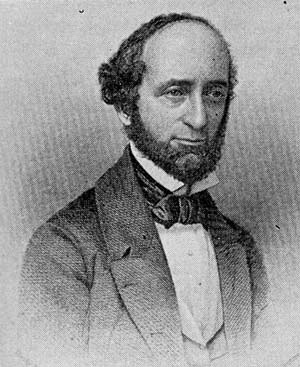
| Home | Information | Contents | Search | Links |
 |
Peter Hamilton Myers, lawyer and novelist, was born in Herkimer, New York, August 4, 1812. His parents removed to Waterford, Saratoga county, later, but in 1826 he was brought to Auburn by his brother, Michael S. Myers, an attorney, and placed in Dr. Rudd's School, and afterwards in Wells College until 1828. In 1829 his brother Michael was County Clerk and made his brother his deputy. The latter continued his law studies and was afterwards a partner in the legal profession with his brother. In 1836 he removed to Little Falls, but soon returned to Auburn, and about 1848 went to Brooklyn. He practiced law in New York City at least from 1848 to 1854, but lived in Brooklyn, and from 1855 to 1863 was listed in the Brooklyn Directories as bookkeeper and clerk. Late in the 1860's he removed to Skaneateles, a village at the northern end of Skaneateles Lake, in Onondaga County, New York, and a few years later, in 1871, he returned to Auburn where he remained until his death, October 30, 1878. On the twenty-eighth he had gone to Syracuse as one of the delegates to escort Roscoe Conkling to Auburn, and in the evening attended Conkling's lecture at the Opera House. Upon his return home he suffered a stroke and died two days later at his home in South Street. He left one son, William, and a daughter, Jessie. His wife, whose maiden name was Swain, died in March, 1878.
Myers wrote some poems and a number of well-written American historical novels, the earliest of which was "The First of the Knickerbockers," published in 1848. This was followed in the same year by "The Young Patroon; or, Christmas in 1690." "The King of the Hurons" appeared in 1850. "Bell Brandon; or, The Great Kentrip Estate," and "The Miser's Heir; or, The Young Millionaire," 1854, were prize tales for which he received $200 each from the Philadelphia Dollar Newspaper. Two other prize stories were "The Gold Crushers" and "Ellen Welles; or, The Siege of Fort Stanwix." Myers was also among the regular contributors to the Knickerbocker Magazine. His last publication in verse was "Ensenore," a tale of a small settlement on the west shore of Owasco Lake in pioneer days.
All of the biographical dictionaries consulted give the place of his death as Brooklyn and the date from August 30, 1878, to November 6, 1878. The date and place given above are presumably correct, being from the obituary notice in the Auburn daily paper.
REFERENCES; Allibone, Dict. Eng. Lit., II, 1396, and Supplement, II, 1162; Appleton's Cyc. Amer. Biog., IV, 1888, 474; Nat. Cyc. Amer. Biog., X, 1919, 485, with portrait; Herringshaw's Encycl. Amer. Biog. of the Nineteenth Century, Chicago, 1906, 685 (gives date of death incorrectly as August 30, 1878, in Brooklyin); Evert A. Duyckinck and George L. Duyckinck, Cyc. Amer. Lit., New York, 1856, 566; The Knickerbocker Gallery, New York, 1855, 233 (portrait only); Oscar Fay Adams, A Dictionary of American Authors, Boston, 1905, 267; Charles D. Warner, Library of the World's Best Literature, XLIII, 1897, 399; Auburn Daily Bulletin, October 30, 1878; New York City Directories, 1848-54; Brooklyn Directories, 1852-63; New York Weekly, XXVI, December 15, 1870, notes the death of Myers' son, Irving P. Myers; XXXIII, April 28, 1878, notes the death of Mrs. Myers; XXXIV, December 9, 1878, gives the date of Myers' death, incorrectly, as November 6, 1878, in Auburn.
Irwin's American Novels. Nos. 7, 25, 30, 32
Dime Novels. No. 220
Starr's American Novels. No. 79
Pocket Novels. Nos. 105, 220
Boy's Library (octavo). No. 257
Pocket Library. No. 456